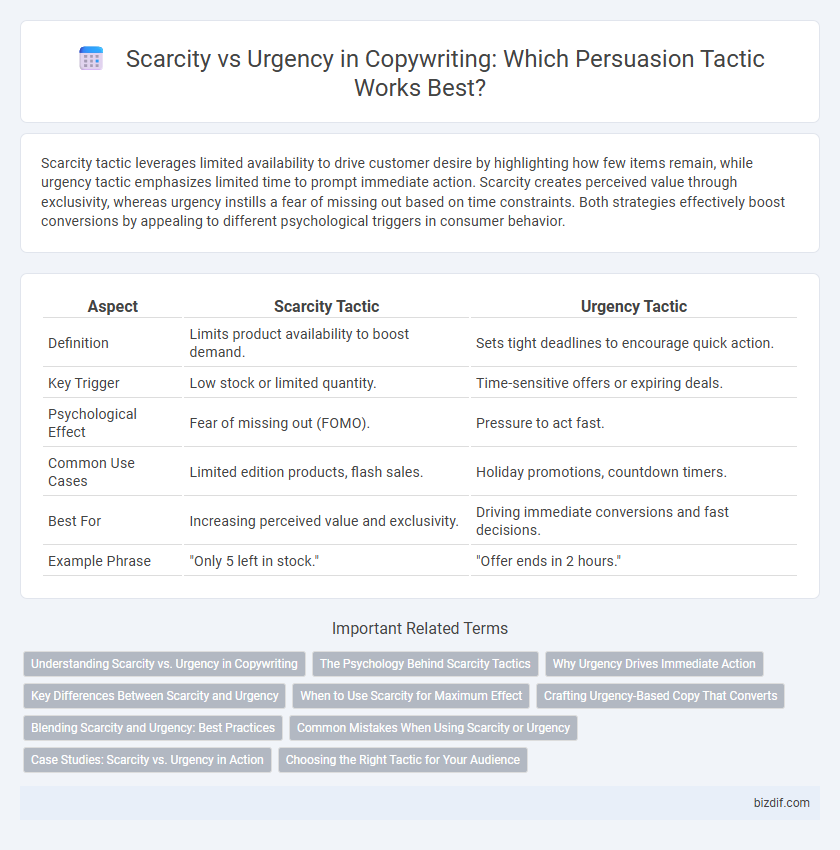Scarcity tactic leverages limited availability to drive customer desire by highlighting how few items remain, while urgency tactic emphasizes limited time to prompt immediate action. Scarcity creates perceived value through exclusivity, whereas urgency instills a fear of missing out based on time constraints. Both strategies effectively boost conversions by appealing to different psychological triggers in consumer behavior.
Table of Comparison
| Aspect | Scarcity Tactic | Urgency Tactic |
|---|---|---|
| Definition | Limits product availability to boost demand. | Sets tight deadlines to encourage quick action. |
| Key Trigger | Low stock or limited quantity. | Time-sensitive offers or expiring deals. |
| Psychological Effect | Fear of missing out (FOMO). | Pressure to act fast. |
| Common Use Cases | Limited edition products, flash sales. | Holiday promotions, countdown timers. |
| Best For | Increasing perceived value and exclusivity. | Driving immediate conversions and fast decisions. |
| Example Phrase | "Only 5 left in stock." | "Offer ends in 2 hours." |
Understanding Scarcity vs. Urgency in Copywriting
Scarcity tactics in copywriting focus on limiting product availability to boost perceived value, such as "only 5 items left," while urgency tactics emphasize time constraints, like "sale ends in 2 hours," to prompt immediate action. Both techniques leverage psychological triggers--scarcity taps into fear of missing out (FOMO) and exclusivity, whereas urgency creates pressure through deadlines. Effective copy balances scarcity and urgency by clearly communicating limited availability and narrowing time frames to maximize conversions.
The Psychology Behind Scarcity Tactics
Scarcity tactics leverage the fear of missing out (FOMO) by signaling limited availability, which activates the brain's loss aversion mechanism and motivates faster purchasing decisions. This psychological trigger causes consumers to assign higher value to products perceived as rare or in short supply, often leading to impulsive buying behavior. Marketers utilize scarcity by highlighting stock limits or exclusive offers to enhance perceived product desirability and urgency.
Why Urgency Drives Immediate Action
Urgency tactics leverage limited-time offers or deadlines to trigger immediate decision-making by activating the brain's fear of missing out (FOMO), leading to faster conversions. Unlike scarcity, which emphasizes limited quantity, urgency emphasizes limited time, creating a pressing need to act now to avoid losing the opportunity. Psychological studies show urgency increases dopamine release, enhancing focus and prompting quicker purchasing behavior in consumers.
Key Differences Between Scarcity and Urgency
Scarcity tactic leverages limited availability of a product or service, creating a perception of exclusivity to boost demand, while urgency tactic emphasizes a time constraint to prompt immediate action. Scarcity often involves quantifiable limits, such as limited stock or limited edition items, whereas urgency centers on deadlines, like flash sales or countdown timers. Both tactics drive conversions effectively but target different psychological triggers: scarcity appeals to fear of missing out (FOMO), and urgency motivates instant decision-making under time pressure.
When to Use Scarcity for Maximum Effect
Use scarcity tactics when the product supply is genuinely limited, such as exclusive editions or limited stock items, to create authentic demand and increase perceived value. Scarcity works best during product launches, flash sales, or special promotions where limited availability can drive immediate purchases. Emphasizing scarcity conditions purchase urgency by triggering fear of missing out (FOMO), but it should be balanced with transparency to maintain customer trust and avoid skepticism.
Crafting Urgency-Based Copy That Converts
Crafting urgency-based copy that converts hinges on triggering immediate action by emphasizing limited-time offers or fast-approaching deadlines. Effective urgency tactics employ time-sensitive language such as "only hours left" or "ends tonight," prompting quick decision-making without overwhelming the reader. Unlike scarcity tactics that highlight limited quantity, urgency strategies focus on the narrowing window of opportunity to boost click-through and conversion rates.
Blending Scarcity and Urgency: Best Practices
Blending scarcity and urgency tactics in copywriting enhances conversion rates by creating a powerful psychological trigger that drives immediate action. Use limited-time offers combined with a restricted quantity to amplify desire, ensuring messaging highlights both the deadline and the finite availability clearly. Incorporate real-time countdown timers and inventory updates to reinforce urgency and scarcity, boosting credibility and encouraging prompt decision-making.
Common Mistakes When Using Scarcity or Urgency
Common mistakes when using scarcity or urgency tactics in copywriting include overusing these strategies, which can lead to consumer skepticism and reduced trust. Misrepresenting availability or deadlines can damage brand credibility and result in higher bounce rates. Failing to align scarcity or urgency with genuine product value decreases conversion rates and may alienate the target audience.
Case Studies: Scarcity vs. Urgency in Action
Case studies reveal that scarcity tactics, such as limited stock alerts, often drive higher purchase intent by leveraging the fear of missing out, while urgency tactics, like countdown timers, boost immediate conversion rates by creating time pressure. Data from e-commerce platforms show scarcity messages can increase sales by up to 15%, whereas urgency triggers lift click-through rates by approximately 10%. Marketers combining both approaches strategically see an average revenue growth of 25%, demonstrating the complementary power of scarcity and urgency in persuasive copywriting.
Choosing the Right Tactic for Your Audience
Choosing between the scarcity tactic and urgency tactic depends on understanding your audience's behavior and motivations. Scarcity appeals to the desire for exclusive or limited items, driving deeper emotional investment by highlighting limited availability, while urgency leverages time-sensitive offers to prompt immediate action. Analyze customer data and preferences to determine whether your audience responds better to exclusivity or the pressure of deadlines for maximum conversion.
Scarcity Tactic vs Urgency Tactic Infographic

 bizdif.com
bizdif.com